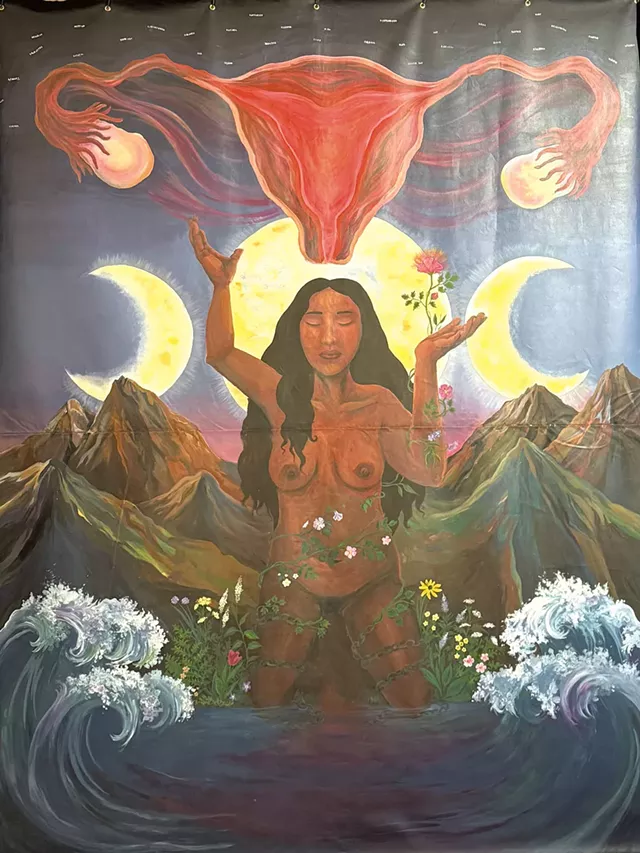“It began as a little idea,” Ella Thomas said, “maybe a painting on the wall of our high school — and then somehow it grew into a 9-by-12-foot mural with an organization to go with it.”
Thomas, a junior at U-32 Middle & High School in East Montpelier, spoke at the March 29 unveiling of a mural celebrating reproductive justice that she painted with fellow student Annaliese Eckhaus. Together with classmates Una Liebermann, Mayla Landis-Marinello and Leela McCann, and their mentor, reproductive health educator Kayla Becker, they have formed HERVermont, an organization spreading awareness about reproductive health, rights and history.
The group grew out of a self-directed learning project in lieu of health class, which the students started as sophomores in fall 2023 with Becker as their teacher. In addition to biology, they studied the 20th-century history of reproductive rights, including how it affected Black and Indigenous women. Their studies spurred them to action, starting with the mural.
Then, in a display of extreme event-planning prowess, the teens arranged a mural unveiling that packed the Montpelier Performing Arts Hub despite a late March snowstorm. An impressive lineup of activist speakers included former Vermont governor Madeleine Kunin, former gubernatorial candidate Esther Charlestin, and, via video, U.S. Rep. Becca Balint (D-Vt.) and historian Scott Stern.
The students read Stern’s book The Trials of Nina McCall as part of their curriculum last spring. It investigated the largely unstudied history of the American Plan, which the author described as “a largely forgotten U.S. government program under which women suspected of promiscuity or of having sexually transmitted infections were incarcerated, without due process, in what some women call concentration camps.”
Stern went on to say that tens of thousands of women in the first half of the 20th century were affected, but because the decentralized program was implemented by local law enforcement, many had no idea that anyone else had been arrested. He also highlighted a history of resistance: “Women locked up under the plan routinely escaped, sued their captors, assaulted their captors and burned their sites of incarceration to the ground.”
Eckhaus, one of the student artists, said the mural was created as a memorial to these women. “As we studied this history,” she said, “we realized that it was too big to leave in historical documents and academic papers, because reproductive justice affects everyone here.”
The mural depicts a female figure kneeling at the edge of a body of water, raising her hands in what seems like a magical gesture. Three moons behind her represent the pagan triple goddess of Mother, Maiden and Crone; flowers and healing herbs grow up her body. A giant uterus floats above her as though summoned. Women’s names — of actual people who were incarcerated and some representing unknown victims — are written in white on a black sky like little stars.
It is remarkably proportional and beautifully painted, though Thomas and Eckhaus said the unveiling was the first time they were seeing it upright. Over the course of several months, they worked on the piece on whatever floor they could find, rolling it up between sessions.
The imagery recalls a 1970s Judy Chicago brand of feminist art, updated for Gen Z. Notably, the figure is brown, as were many of the women who were incarcerated under the American Plan. Eckhaus said they decided on the imagery as a way of destigmatizing and honoring the female body.
More than unveiling the artwork, the event was a launch for HERVermont. The students don’t have a permanent home for the mural but hope to travel with it to schools and other venues as part of a campaign of education and activism.
During the event, Kunin lauded the teens for their work, describing their journey as mirroring her own start in the political sphere. First, she said, she got angry. “The anger turns into imagination,” she said. “Anger, imagination and then action.”

